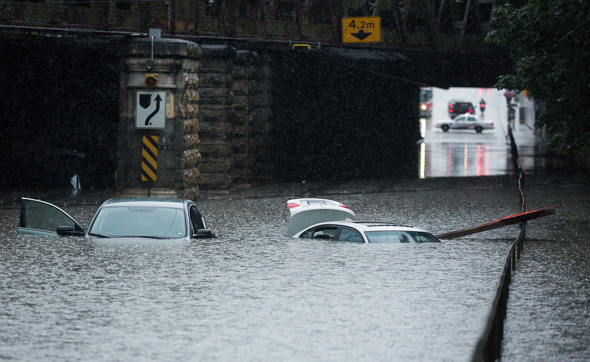What everyone forgot was that the city was built on water in the first place. The entire downtown used to be a river delta criss-crossed by creeks and rivers. After the epidemics of the mid-nineteenth century, the waterways were forced underground and integrated with the brand-new municipal sewer system.
Some of the rivers were already underground. They just discovered a new one about ten years ago, a leftover glacier channel created during the last Ice Age. The water is very cold, very clean, and very old. It flows about ten metres underground, through a layer of gravel deposited ten thousand years ago. The rate of flow is about a metre per year.
Two days ago there was what they're calling a "fifty-year flood." More water fell in six hours than the city normally gets in four weeks this time of year, and there was severe enough flooding to close every major highway and thoroughfare, for the very straightforward reason that they were all underwater. Basements were drowned; King Street was navigated by kayak.
Fifty-year flood is a nice, romantic way of putting it, but everyone forgets. Ten years ago there was a rainstorm so sudden and intense the water fell in ropes, and a three-metre sinkhole opened right in the middle of Eglinton Avenue. That's eight kilometres from the lake on supposedly high ground, in a relatively new part of town. In fact, the older neighbourhoods and buildings tended to do a little better, because they were built in eras when developers weren't so cocksure they could out-engineer nature.
In the west end, at the line where the city proper ends and the inner suburbs begin, a man went to parallel park his car on the street yesterday. He owns an underground parking spot in a nearby condominium highrise, but of course he couldn't use it because the parking garage was flooded. He was the first one to report the curb and sidewalk had shifted about twenty centimetres to the south.
At first it looked like there had been small earthquake as well as a flood, but as city inspectors traced the fault line, they realised what was happening. The water underground isn't just rising. It's lifting. It's rotating.
The entire city sits on a bed of water, and has become a floating island.
The engineers tell us that the displacement must be immense, and that the shifting will be minimal. Eventually, they say, the water will drain into the lake and the city will settle again. Buildings near the island's edge may experience some structural damage in the foundations, but overall it won't be anything major.
But everyone forgets. That's what they always say.
Some of the rivers were already underground. They just discovered a new one about ten years ago, a leftover glacier channel created during the last Ice Age. The water is very cold, very clean, and very old. It flows about ten metres underground, through a layer of gravel deposited ten thousand years ago. The rate of flow is about a metre per year.
Two days ago there was what they're calling a "fifty-year flood." More water fell in six hours than the city normally gets in four weeks this time of year, and there was severe enough flooding to close every major highway and thoroughfare, for the very straightforward reason that they were all underwater. Basements were drowned; King Street was navigated by kayak.
Fifty-year flood is a nice, romantic way of putting it, but everyone forgets. Ten years ago there was a rainstorm so sudden and intense the water fell in ropes, and a three-metre sinkhole opened right in the middle of Eglinton Avenue. That's eight kilometres from the lake on supposedly high ground, in a relatively new part of town. In fact, the older neighbourhoods and buildings tended to do a little better, because they were built in eras when developers weren't so cocksure they could out-engineer nature.
In the west end, at the line where the city proper ends and the inner suburbs begin, a man went to parallel park his car on the street yesterday. He owns an underground parking spot in a nearby condominium highrise, but of course he couldn't use it because the parking garage was flooded. He was the first one to report the curb and sidewalk had shifted about twenty centimetres to the south.
At first it looked like there had been small earthquake as well as a flood, but as city inspectors traced the fault line, they realised what was happening. The water underground isn't just rising. It's lifting. It's rotating.
The entire city sits on a bed of water, and has become a floating island.
The engineers tell us that the displacement must be immense, and that the shifting will be minimal. Eventually, they say, the water will drain into the lake and the city will settle again. Buildings near the island's edge may experience some structural damage in the foundations, but overall it won't be anything major.
But everyone forgets. That's what they always say.
